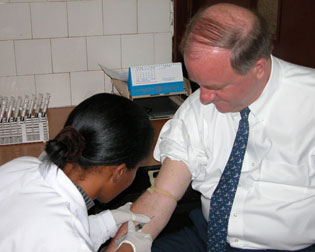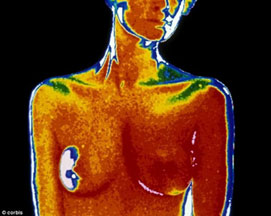|

Trashing e-waste can harm your health
By Carol Aloysius
It is relatively a new word that has entered our vocabulary,
especially in Asian countries where modern technology has only been
introduced a few decades ago. An acronym for Electronic waste, e-waste
refers to all electronic appliances that have become old and non usable
and need to be disposed of.
Discarded electronics contain hazardous materials. If disposed
improperly, they pose a potential threat to human health and the
environment. E-waste accounts for 40 percent of the lead and 75 percent
of the heavy metals found in landfills. Although safe when used, once
electronics are discarded in a landfill, the acidic conditions provide
an environment in which lead and other heavy metals may leak out. If the
landfill's liner fails, the groundwater supply may become contaminated.
 Rapid advances in hi tech information in recent years has seen this
country inundated by television sets, computers, laptops, cell
phones,VCRs, stereos and other electronic products. While these
electronic products on one hand, have spurred economic growth, changed
information technology and improved peoples lives in many ways, our
increasing dependence on them at home and at our workplaces, has led to
a new hazard: electronic waste which has a negative impact on our
health. For e-waste is toxic and if not disposed of safely and quickly,
could be a potential danger to human health and to life on our planet by
its negative impact on the environment, says an expert in the field. Rapid advances in hi tech information in recent years has seen this
country inundated by television sets, computers, laptops, cell
phones,VCRs, stereos and other electronic products. While these
electronic products on one hand, have spurred economic growth, changed
information technology and improved peoples lives in many ways, our
increasing dependence on them at home and at our workplaces, has led to
a new hazard: electronic waste which has a negative impact on our
health. For e-waste is toxic and if not disposed of safely and quickly,
could be a potential danger to human health and to life on our planet by
its negative impact on the environment, says an expert in the field.
Head of the Toxicology Unit at the National Hospital of Sri Lanka Dr
Waruna Gunathilake discusses with the Sunday Observer what e-waste
contains, its impacts on human health and the environment in general,
and how we can dispose of it safely.
Excerpts
Question: What is e-waste?
Answer: E-Waste or electronic waste is an informal term for
all the electronic appliances which need to be disposed off due to their
non-usability. Their non-usability could be attributed to number of
reasons such as newer upgrade or damage beyond repair or incompatibility
with other appliances. Computers, television sets, laptops, cell phones,
VCRs, refrigerators, stereos are just few common electronic products
that generate e-waste.
In recent years, advances in consumer electronics and personal
computers have spurred economic growth, changed information technology
and improved people lives in countless ways. However, our growing
dependence on electronic products both at home and in the workplace has
given rise to a new hazard: electronic waste. With the rapid growth of
technology and shorter product life cycles of electronic products,
e-waste is one of the fastest growing segments of our nation's trash.
Q: Since they range from household to workplace items, can you
elaborate on the electronic items and accessories you would call
e-waste?
A: They include the following:
Computer Accessories
CD-Rom Drives
Computer Keyboards
Computer Mouse
DVD Drives
External Hard Drive
Floppy-Disk Drives
HD-DVD Drives
Modems (Wired and
Wireless) Computers
Computer Terminals
Desktop Computers
Mini Notebooks,
Computers Monitors
All-in-One Computers
Closed Circuit Monitors
Dual Computer Monitors
Monitors
Professional Displays
Up to 29 Image, Audio and Video
Audio Cassette Players / Recorders
CD Players / Recorders
Digital Picture Frames
Handheld Personal Computers
Home Radios
Portable Audio/ Video Players
Portable DVD Players
Portable MP3/Digital Audio
Players
Portable Radios
Projectors (Video, Audio, Image)
Stereo Amplifiers
Video Cameras
DVD / VCR / Blu-Ray
Webcams
Televisions up to 29,
Telephone Equipment
Answering Machines
Cordless Telephone
Pagers
Telephone (Rotary), Vehicle
Audio and Video
Vehicle DVD / Blu-ray
Radios, Audio Players
Speakers, Printing Devices
Camera Dock Printers
Desktop Copiers
Desktop Printers
Fax Machines
Handheld Printers
Portable Photo Printers
Typewriters (Electric),
Mobile Phone Equipments
Mobile Phones
Mobile Phone Batteries
Chargers All Electronic
Surgical Items
Q. What exactly do they contain which makes them harmful to
our health?
A. While e-waste contains both valuable materials such as
gold, palladium, silver and copper, it also contains harmful substances
like lead, cadmium and mercury. In the absence of suitable techniques
and protective measures, recycling e-waste can result in toxic emissions
to the air, water and soil and pose a serious health and environmental
hazard.
Q. Where does this waste usually end up in Sri Lanka?
A. According to European standards, e-waste, accounted for
over two million tons of hazardous waste in 2007. However, only 18
percent was actually recycled. The bulk of e-waste ended up in
landfills. E-waste contains several highly toxic ingredients including
lead, cadmium and mercury. In landfills, these toxins can leach into
soils and possibly contaminate groundwater.
Q. What are the health impacts?
A. Cadmium exposure, for example, can cause kidney damage and
cancer in humans. Lead exposure in children can cause brain damage.
Possible Symptoms Associated with E-waste:
Brain damage
Decreased growth
Hyperactivity
Impaired hearing
Disorders of the reproductive and nervous systems
Blood and kidney disorders
Symptoms of poisoning
Physical weakness
Strong allergic reactions
Asthmatic bronchitis
DNA damage
Neuro-toxic effects in children
Endocrine and hormone disorders
Increased risk of digestive and lymph system cancers
Q. How can they be disposed of safely?
A. Disposal of household hazardous waste in the trash is
potentially harmful. Compact fluorescent bulbs (CFLs) contain small
quantities of mercury. European standards require that you place broken
bulbs in a plastic bag or sealed container for disposal. If disposed of
improperly, mercury vapour can enter the air. Mercury poses the greatest
risk to unborn children, causing neurological damage.
Q. Is it true that even when disposed of correctly, e-waste
can still cause health hazards?
A. That depends on the way and methods used in their disposal.
One common method of treating toxic waste is by incineration.
However, incineration can release contaminants into the air such as
dioxins. Dioxins are by-products of herbicide production. Long-term
exposure to these poisonous chemicals can cause nervous system
disorders. Even short-term exposure carries risks including skin lesions
and impaired liver function.
Q. How can these adverse health impacts be reduced?
A. One way to mitigate the health effects of toxic waste
disposal is to recycle these materials. Recycling keeps these waste
products from landfills and reduces the risk of environmental impacts.
Q. What is your message to the public on e-waste disposal?
A. It is our duty to properly dispose the e-waste. We must use
the electronic products carefully so as to prolong the life of the
equipment. Dont upgrade an electronic gadget or buy new ones unless it
is absolutely necessary to do so.
As responsible citizens, we must be fully informed on what happens to
these items when we decide to dispose of them. Question your scrap
dealers, because scrap dealers and second hand retailers have formed a
vicious chain which results in e-waste being dumped unsafely.
Q. What are Persistent Organic Pollutant and Health Hazards.
Are they also part of e-waste?
A. Persistent organic pollutants (POPs) are organic compounds
that are resistant to environmental degradation through chemical,
biological, and photolytic processes.[1] Because of this, they have been
observed to persist in the environment, to be capable of long-range
transport, bio-accumulation in human and animal tissue, bio-magnified in
food chains,[1] and to have potential significant impacts on human
health and the environment.
Many POPs are currently or were in the past used as pesticides.
Others are used in industrial processes and in the production of a range
of goods such as solvents, polyvinyl chloride, and pharmaceuticals.
POPs are created by humans in industrial processes, either
intentionally or as by-products. Due to their chemical properties, many
POPs are semi-volatile and insoluble. These compounds are therefore
unable to transport directly through the environment.
The indirect routes include attachment to particulate matter, and
through the food web. The chemicals semi-volatility allows them to
travel long distances through the atmosphere before being deposited.
POP exposure can cause death and illnesses including disruption of
the endocrine, reproductive, and immune systems; behavioural disorders;
and cancers possibly including breast cancer.
Exposure to POPs can take place through diet, environmental exposure,
or accidents. Knowledge of the bio-availability of the pollutant as well
as the hazard and dose/response relationship is essential in performing
a human health risk assessment.
POP link to diabetes
Q. Is there a link between POPs and diabetes?
A. Scientific studies indicated a link between blood serum
levels of POPs and diabetes. Individuals with elevated levels of
persistent organic pollutants (DDT, dioxins, PCBs and Chlordane, among
others) in their body were found to be up to 38 times more likely to be
insulin resistant than individuals with low levels of these pollutants.
As most exposure to POPs is through consumption of animal fats, study
participants with high levels of serum POPs are also very likely to be
consumers of high amounts of animal fats, and thus the consumption of
the fats themselves, or other associated factors may be responsible for
the observed increase in insulin resistance. Another possibility is that
insulin resistance causes increased accumulation of POPs.
Among study participants, obesity was associated with diabetes only
in people who tested high for these pollutants.
These pollutants are accumulated in animal fats, so minimising
consumption of animal fats may reduce the risk of diabetes.
Q. What about vegetables and fruits? Are they also at risk to
e-waste contamination?
A. Heavy Metal Contamination of vegetables and fruits are
becoming important as they contribute nutrients and fibres to human
diet. Urbanisation and industrialisation have contributed heavy metals
to agriculture soils and consequently in food chains.
Agricultural activities, pesticides and waste water irrigations,
transportations and marketing practices, industrial and vehicular
emissions have increased heavy metals in vegetable and fruits.
Concentration of copper, Zink, cadmium and lead in locally grown
vegetables (spinach, ladies fingers, tomato, radish, cabbage) is
important in these aspects.
Q. So how can these risk be minimised? Your message?
A. Steps should be taken for efficient treatments of waste
water and reduce the extent of heavy metal contamination in irrigation
water, vegetables and fruits.
It is a well known fact that farmers use chemicals on vegetables and
fruits to ripen them artificially, or preserve them and make them look
fresh. It is also a well known fact that local farmers use more
agrochemicals than the recommended amounts. Educating farmers on
moderate use of chemicals is one way to reduce such pollution.
(For more information contact the Toxicology and Poisons Centre,
National Hospital, Colombo. Hotline 2686143, or e-mail questions to:
[email protected])
HIV testing in young adolescents
 Having high knowledge about HIV and engaging in risky sexual activity
do not make high-school-aged teens more likely to get tested for HIV.
Those are the findings of a new study. The study of nearly 1,000 Bronx,
NY teens found those most likely to be tested for HIV had strong partner
communication about HIV and were in committed relationships. This is the
first-ever study to understand the role that partners play in HIV
testing behaviour of this patient population. Having high knowledge about HIV and engaging in risky sexual activity
do not make high-school-aged teens more likely to get tested for HIV.
Those are the findings of a new study. The study of nearly 1,000 Bronx,
NY teens found those most likely to be tested for HIV had strong partner
communication about HIV and were in committed relationships. This is the
first-ever study to understand the role that partners play in HIV
testing behaviour of this patient population.
Despite efforts to educate about the risks of HIV and AIDS in
schools, it is clear that more is needed to prompt adolescents to speak
up and take the next step of getting tested, said Hina J. Talib,
adolescent medicine physician. Early identification of HIV in
adolescents is associated with earlier treatment and better health
outcomes, so it is especially important that these sexually active
high-school-aged adolescents be tested.
The computer-assisted survey was completed by 980 sexually active 14
to 17-year-olds living in the Bronx, an area with a high AIDS burden.
More than half of those surveyed were female (56 percent) and Latino (55
percent), and 428 (44 percent) had been tested for HIV. In addition, 54
percent of those in a serious committed relationship had been tested for
HIV, compared to 44 percent of all participants. Sixty percent of those
who had high HIV-related partner communication got tested and 48 percent
of those who reported high openness of communication and comfort
discussing sex with their partners had been tested for HIV. Participants
who had high HIV/AIDS-related partner communication were 3.7 times more
likely to have been tested than those with low communication. High HIV
knowledge includes understanding of transmission of HIV, protection from
exposure and treatment.
These findings highlight opportunities for healthcare providers to
include a discussion of the partner's testing status when counselling
adolescents about HIV testing, said Dr. Talib. We should include
partner communication modules when designing high impact interventions
to encourage HIV testing for these minority adolescents who need it
most.
- MNT
Combo of plant nutrients kills breast cancer cells
A study has found that a super cocktail of six natural compounds in
vegetables, fruits, spices and plant roots killed 100 percent of sample
breast cancer cells without toxic side effects on normal cells.
 One of the primary causes of both the recurrence of breast cancer
and deaths is a small group of cancer stem cells that evade therapy,
says researcher Dr. M. Raj. These often multi-drug-resistant cells have
the ability to generate new tumours, so it is critically important to
develop new approaches to more effective and safer treatment or
prevention of breast cancer. One of the primary causes of both the recurrence of breast cancer
and deaths is a small group of cancer stem cells that evade therapy,
says researcher Dr. M. Raj. These often multi-drug-resistant cells have
the ability to generate new tumours, so it is critically important to
develop new approaches to more effective and safer treatment or
prevention of breast cancer.
The research team tested ten known protective chemical nutrients
found in foods such as broccoli, grapes, apples, tofu, and turmeric root
(a spice used in Indian curry) before settling upon six? Curcumin known
as tumeric, Isoflavone from soybeans, Indo-3-Carbinol from cruciferous
plants, C-phycocyanin from spirulina, Reservatrol from grapes, and
Quercetin, a flavonoid present in fruits, vegetables, and tea.
The researchers administered these six at bioavailable levels to both
breast cancer and control cells. They tested the compounds individually
and in combination.
They found that the compounds were ineffective individually. When
combined, though, the super cocktail suppressed breast cancer cell
growth by more than 80 percent, inhibited migration and invasion, caused
cell cycle arrest, and triggered the process leading to cell death
resulting in the death of 100 percent of the breast cancer cells in the
sample.
- MNT
Obese women at higher risk of hearing loss
 According to the World Health Organisation, 360 million people have
disabling hearing loss a condition that is often considered to be an
unavoidable side effect of ageing. New research finds that a higher body
mass index (BMI) and larger waist circumference are each associated with
higher risk of hearing loss, while a higher level of physical activity
is associated with lower risk of hearing loss in women. According to the World Health Organisation, 360 million people have
disabling hearing loss a condition that is often considered to be an
unavoidable side effect of ageing. New research finds that a higher body
mass index (BMI) and larger waist circumference are each associated with
higher risk of hearing loss, while a higher level of physical activity
is associated with lower risk of hearing loss in women.
We often think of hearing loss as an inevitable part of the ageing
process, but these findings provide evidence that potentially modifiable
risk factors, such as maintaining a healthy weight and staying
physically active, may help in the prevention of hearing loss or delay
its progression, said Sharon Curhan, MD, a researcher in the Channing
Division of Network Medicine at BWH.
Using data from 68,421 women in the Nurses Health Study II who were
followed from 1989 to 2009, researchers analysed information on BMI,
waist circumference, physical activity, and self-reported hearing loss.
The baseline and updated information was obtained through validated
biennial questionnaires.
Researchers found that women with a BMI of 30-34 had a relative risk
for hearing loss that was 17 percent higher, and with a BMI of 40 or
more had a relative risk that was 25 percent higher, when compared with
those with a BMI of less than 25.
-medicalxpress |

